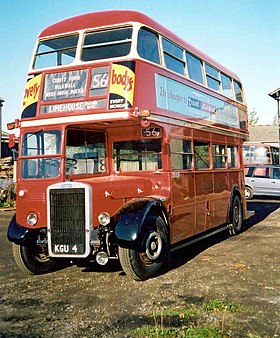Leyland Titan (front engined double-decker)
| Leyland Titan | |
|---|---|

Metro-Cammell-bodied Leyland Titan PD2-7RT, London Transport fleet number RTL554.
|
|
| Overview | |
| Manufacturer | Leyland Motors/British Leyland, Leyland and Farington Lancashire, see also Ashok Leyland |
| Production | 1927 - 1942 1945 - 1969 |
| Body and chassis | |
| Doors | generally rear open-platform, but various customer options. |
| Floor type | Step entrance |
| Powertrain | |
| Engine | Leyland, 6–cylinder, petrol (until 1939) or direct-injection diesel from 1933, standard by 1938, see text. |
| Chronology | |
The Leyland Titan was a forward-control chassis with a front-mounted engine designed to carry double-decker bus bodywork. It was built mainly for the UK market between 1927 and 1942, and between 1945 and 1969.
The type was widely used in the United Kingdom and it was also successful in export markets, with numerous examples shipped to Australia, Ireland, India, Spain, South Africa and many other countries. From 1946 specific export models were introduced, although all Titans were right-hand drive regardless of the rule of the road in customer countries.
After Leyland ended the production of the Leyland Titan in UK, Ashok Leyland of India took up production and marketed the bus in South Asia as the Ashok Leyland Titan, which, in much developed form, is still in production.
Prior to 1924 Leyland Motors and the majority of other British commercial vehicle makers had used similar chassis frames for bus and lorry chassis, generally a simple straight ladder-type steel frame. The disadvantage for bus applications was that the saloon floor was relatively high, which gave passengers access difficulties and also caused stability and overall height problems if a double-deck was to be fitted with a top deck cover, as was increasingly becoming common on double-deck trams in the UK and had been first used on buses by Widnes Corporation in 1909. When the London General Omnibus Company, part of the Underground Electric Railways of London Group, proposed a closed-top double-decker to the group's vehicle-building subsidiary the Associated Equipment Company in 1923, the model 405 was produced, forming General's NS class; this had a frame with side members upswept over the axle mounting points so that the lower saloon floor level was about one foot lower than the preceding types 301 (K-class) and 401 (S-class). However, the Metropolitan Police, who then had the statutory responsibility for London bus construction and safety rules, refused the fitting of covered top decks on the NS class for a number of years after its introduction. Initially the NS was built exclusively for the Underground Group, and certain features – such as the four-cylinder side-valve engine and three-speed chain-drive constant-mesh transmission – were obsolescent. In 1924 Maudslay of Coventry also introduced a swept-down chassis frame on a comprehensive range of purpose-built passenger models called the ML series, although no double-deckers were catalogued until 1930.
...
Wikipedia
